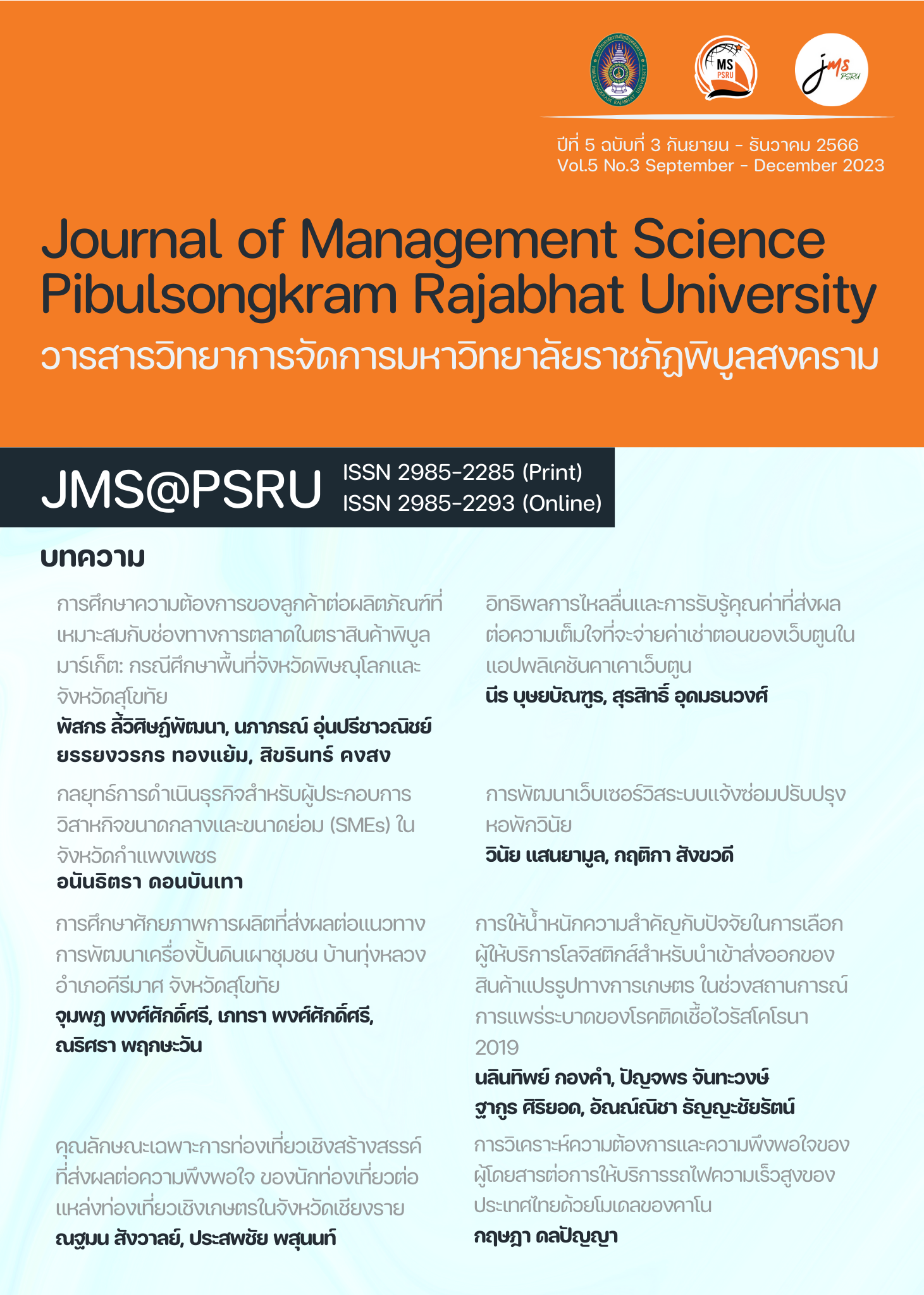การวิเคราะห์ความต้องการและความพึงพอใจของผู้โดยสารต่อการให้บริการรถไฟความเร็วสูงของประเทศไทยด้วยโมเดลของคาโน
คำสำคัญ:
โมเดลของคาโน , รถไฟความเร็วสูง , สมรรถนะด้านโลจิสติกส์บทคัดย่อ
การศึกษานี้มีวัตถุประสงค์เพื่อวิเคราะห์ความต้องการและความพึงพอใจของผู้โดยสารที่มีต่อบริการรถไฟความเร็วสูงของประเทศไทยด้วยโมเดลของคาโน ซึ่งเป็นวิธีการที่ใช้ในการจัดหมวดหมู่ความต้องการและความพึงพอใจของลูกค้า ซึ่งสามารถแบ่งออกเป็น 5 ประเภทได้แก่ ดึงดูดใจ ทิศทางเดียวกัน จำเป็นต้องมี ไม่มีความแตกต่าง และทิศทางตรงกันข้าม การศึกษานี้เป็นการรวบรวมข้อมูลจากผู้โดยสารรถไฟความเร็วสูงผ่านการสำรวจโดยใช้แบบสอบถามสองทิศทางของคาโน โดยการศึกษานี้ใช้การสุ่มตัวอย่างแบบบังเอิญกลุ่มตัวอย่างประกอบด้วย 374 คน ที่รวบรวมจากการทำแบบสอบถามออนไลน์ผ่าน Google Forms การศึกษานี้นำเสนอการระบุคุณลักษณะที่จำเป็นที่เกี่ยวข้องกับมุมมองสมรรถนะด้านโลจิสติกส์ เช่น เวลาต้นทุน และความน่าเชื่อถือ มีการจัดลำดับความสำคัญเพื่อตอบสนองความต้องการและความพึงพอใจของลูกค้า ผลการวิจัยพบว่าช่วงอายุ 41-60 ปีมีความแตกต่างในแง่ของคุณลักษณะเมื่อเทียบกับกลุ่มผู้มีอายุน้อยกว่าซึ่งกลุ่มนี้เป็นกลุ่มที่ให้ความสำคัญมากต่อมุมมองด้านความน่าเชื่อถือ เช่นมีตารางการเดินรถไฟที่แน่นอนมีเจ้าหน้าที่ความปลอดภัยบนขบวนรถไฟและความสะอาดของรถไฟ ผลการศึกษาให้ข้อมูลเชิงลึกเกี่ยวกับคุณลักษณะสำคัญที่มีอิทธิพลต่อความต้องการและความพึงพอใจของผู้โดยสาร รวมทั้งทำให้ผู้ให้บริการรถไฟความเร็วสูงสามารถปรับปรุงการให้บริการเพื่อตอบสนองความต้องการของลูกค้าได้อย่างมีประสิทธิภาพมาก
เอกสารอ้างอิง
การรถไฟแห่งประเทศไทย. (2562). 122 ปี ก้าวสู่อนาคตรถไฟไทย. สืบค้น 24 สิงหาคม 2565, จาก http://backup.co.th/srt/publication/122_Years_and_the_Future_of_SRT/report/index.html
กองโลจิสติกส์. (2562). Industrial Logistics Performance Index..Key Success Factor ตัวชี้วัดประสิทธิภาพด้านโลจิสติกส์..ปัจจัยสู่ความสำเร็จ. สืบค้น 24 สิงหาคม 2565, จากhttps://dol.dip.go.th/th/category/2019-02-08-08-57-30/2019-03-15-09-09-00
สำนักงานสภาพัฒนาการเศรษฐกิจและสังคมแห่งชาติ. (2562). รายงานโลจิสติกส์ของประเทศไทยประจำปี 2561. สืบค้น 24 สิงหาคม 2565, จาก https://www.nesdc.go.th/ewt_dl_link.php?nid=9359
Ardakani, A. S., Ghannad, S. B., Sadrabadi, M. M., & Shakerian, H. (2018). Service Design by Identification and Prioritization of Customer Demands in Kano Model: A Step Towards the Quality Function Deployment (QFD) and the Productivity Improvement. Industrial Engineering & Management Systems, 17(3), 600-612.
Berger, C., Blauth, R., & Boger, D. (1993). Kano’s Methods for Understanding Customer-Defined Quality. Center for Quality of Management Journal, 2(4), 3-36.
Blainey, S., Hickford, A., & Preston, J. (2012). Barriers to Passenger Rail Use: A Review of the Evidence. Transport Reviews, 32(6), 675-696.
Chaudha, A., Jain, R., Singh, A., & Mishra, P. (2011). Integration of Kano’s Model into Quality Function Deployment (QFD). The International Journal of Advanced Manufacturing Technology, 53(5), 689-698.
Cheng, Y.-H. (2010). High-Speed Rail in Taiwan: New Experience and Issues for Future Development. Transport policy, 17(2), 51-63.
Eboli, L., & Mazzulla, G. (2015). Relationships Between Rail Passengers’ Satisfaction and Service Quality: A Framework for Identifying Key Service Factors. Public Transport, 7, 185-201.
Huang, C.-C., & Guan, S.-S. (2012). Application of Kano Model in Study of Satisfaction with Quality of Website Browsing Environment. Bulletin of Japanese Society for the Science of Design, 59(1), 49-58.
Ibrahim, A. N. H., Borhan, M. N., & Ismail, A. (2020). Rail-Based Public Transport Service Quality and User Satisfaction–A Literature Review. Promet-Traffic & Transportation, 32(3), 423-435.
Kano, N., Seraku, K., Takahaski, F., & Tsuji, S. (1984). Attractive Quality and Must-Be Quality. Hinshitsu (Quality, The Journal of Japanese Society for Quality Control), 14(2), 39-48.
Krejcie, R. V., & Morgan, D. W. (1970). Determining Sample Size for Research Activities. Educational and psychological measurement, 30(3), 607-610.
Madzík, P., Budaj, P., Mikuláš, D., & Zimon, D. (2019). Application of the Kano Model for a Better Understanding of Customer Requirements in Higher Education-A Pilot Study. Administrative Sciences, 9(1), 1-18.
Matzler, K., Hinterhuber, H. H., Bailom, F., & Sauerwein, E. (1996). How to Delight Your Customers. Journal of Product & Brand Management, 5(2), 6-18.
McCrindle, M. & Felll, A. (2021). Generation Alpha. United Kingdom: Headline Home
Niu, H., Yao, J., Zhao, J., & Wang, J. (2019). SERVQUAL Model Based Evaluation Analysis of Railway Passenger Transport Service Quality in China. Journal on Big Data, 1(1), 1-17.
Rashid, M. M. (2010). A Review of State-of-Art on Kano Model for Research Direction. International Journal of Engineering Science and Technology, 2(12), 7481-7490.
Redfern, R., & Davey, C. L. (2003). Supply Chain Market Orientation in New Product Development in the UK: A Pilot Case Study. Journal of Fashion Marketing and Management: An International Journal, 7(1), 65-77.
Sauerwein, E., Bailom, F., Matzler, K., & Hinterhuber, H. H. (1996). The Kano Model: How to Delight Your Customers. In Preprints Volume I of the IX. International Working Seminar on Production Economics (pp. 313 -327). Innsbruck: Austria.
Shen, X.-X., Tan, K. C., & Xie, M. (2000). An Integrated Approach to Innovative Product Development using Kano’s Model and QFD. European Journal of Innovation Management, 3(2), 91-99.
Vickerman, R. (1997). High-Speed Rail in Europe: Experience and Issues for Future Development. The annals of regional science, 31(1), 21-38.
Witell, L., Löfgren, M., & Dahlgaard, J. J. (2013). Theory of Attractive Quality and the Kano Methodology–The Past, the Present, and the Future. Total Quality Management & Business Excellence, 24(11-12), 1241-1252.
Xu, Q., Jiao, R., Yang, X., Helander, M., Khalid, H., & Opperud, A. (2007). Customer Requirement Analysis Based on An Analytical Kano Model. In Industrial Engineering and Engineering Management 2007 IEEE International Conference. Singapore: Nanyang Technological University
Xu, Q., Jiao, R. J., Yang, X., Helander, M., Khalid, H. M., & Opperud, A. (2009). An Analytical Kano Model for Customer Need Analysis. Design studies, 30(1), 87-110.
Yamane, T. (1973). Statistics : An Introductory Analysis (3rd ed.). New York: Harper and Row.
Yang, Q., Chan, C. Y., Chin, K.-s., & Li, Y.-l. (2021). A Three-Phase QFD-Based Framework for Identifying Key Passenger Needs to Improve Satisfaction with the Seat of High-Speed Rail in China. Transportation, 48(5), 2627-2662.
Zhang, A., Liu, L., & Liu, G. (2020). High-Speed Rail, Tourist Mobility, and Firm Value. Economic Modelling, 90, 108-116.
ดาวน์โหลด
เผยแพร่แล้ว
รูปแบบการอ้างอิง
ฉบับ
ประเภทบทความ
สัญญาอนุญาต
ลิขสิทธิ์ (c) 2023 มหาวิทยาลัยราชภัฎพิบูลสงคราม

อนุญาตภายใต้เงื่อนไข Creative Commons Attribution-NonCommercial-NoDerivatives 4.0 International License.
บทความที่ได้รับการตีพิมพ์ในวารสารวิทยาการจัดการมหาวิทยาลัยราชภัฏพิบูลสงคราม เป็นลิขสิทธิ์ของ คณะวิทยาการจัดการ มหาวิทยาลัยราชภัฎพิบูลสงคราม บทความที่ลงพิมพ์ใน วารสารวิทยาการจัดการมหาวิทยาลัยราชภัฎพิบูลสงคราม ถือว่าเป็นความเห็นส่วนตัวของผู้เขียน คณะบรรณาธิการไม่จำเป็นต้องเห็นด้วย ผู้เขียนต้องรับผิดชอบต่อบทความของตนเอง



